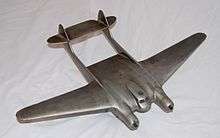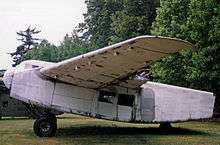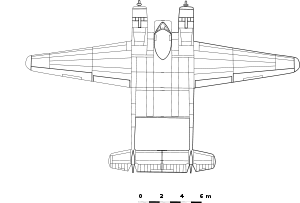Burnelli CBY-3
The Burnelli CBY-3 Loadmaster is an unconventional transport aircraft that was designed by American engineer Vincent Burnelli and built in Canada in 1944 by Canadian Car and Foundry.
| CBY-3 | |
|---|---|
 | |
| The Loadmaster at an airport in Virginia, USA (c. 1959) | |
| Role | Airliner |
| National origin | Canada |
| Manufacturer | Canada Car and Foundry |
| Designer | Vincent Burnelli |
| Number built | 1 |
| Developed from | Burnelli UB-14 |
Design and development

The CBY-3 "lifting fuselage" was an evolution of the earlier Burnelli UB-14. Burnelli worked as a designer at Canadian Car and Foundry (CanCar) in Montreal, and the CBY-3 was intended for bush operations in northern Canada. The sole prototype was extensively tested but failed to gain a production contract.
Burnelli had a lifelong career devoted to exploiting the advantages of the lifting body airfoil concept that characterized many of his earlier aircraft designs. His last design, the CBY-3 was manufactured by CanCar in Montreal, but ownership reverted to Burnelli, when the CBY-3 was unable to gain a production contract. The name of the aircraft, CBY-3, was derived from the name of the three partners involved in its creation: CanCar, Burnelli and Lowell Yerex and "3" from the number of partners involved. Lowell Yerex was a New Zealander who had formed TACA – Transportes Aéreos Centroamericanos (Central American Air Transport) in Honduras in 1931, and joined the project when Burnelli convinced him that the CBY-3 could be used as both a cargo and passenger aircraft.
A follow-up design in 1942 for the CC&F B-1000, a bomber using the same lifting body principles, remained a "paper project".[1]
Operational history
.jpg)
Originally registered CF-BEL-X while still in the experimental stage, this one-off, twin-boom, aerofoil-section fuselage, high-lift airliner garnered significant interest from the industry. CF-BEL-X underwent rigorous testing and proving flights designed to show off its potential. Despite a trouble-free test program and glowing accolades from the press and industry observers, no production orders resulted and the prototype was later sold in the United States as N17N.
Moving to Southampton, New York, Burnelli continued to promote his airfoil-shaped fuselage transport aircraft. In 1955, he adapted the CBY-3 to carry an expedition of 20 passengers and 41 sled dogs, along with their equipment, to the North Pole, but the enterprise was canceled.
The Loadmaster continued to fly regularly as a commercial airliner both in northern Canada and South America; acquired with design rights by Airlifts Inc. in Miami, Florida, it went to Venezuela, and returned to Burnelli Avionics for refitting with Wright R-2600 engines, finally ended its flying days at Baltimore's airport in Maryland.
Aircraft on display

In 1964, the CBY-3 air transport was retired to the New England Air Museum in Windsor Locks, Connecticut, where it was displayed outside. As of January 2015, the aircraft had been moved into the museum's restoration hangar and was being worked by a team of volunteers.[2]
Specifications (CBY-3)

Data from Jane's all the World's Aircraft 1947[3]
General characteristics
- Crew: 3
- Capacity: 22 pax combi or 38 pax only / 1,170 cu ft (33 m3) capacity
- Length: 54 ft 6 in (16.61 m)
- Wingspan: 85 ft 11 in (26.2 m)
- Height: 13 ft 4 in (4.06 m)
- Wing area: 629 sq ft (58.4 m2)
- Empty weight: 16,800 lb (7,620 kg)
- Gross weight: 27,000 lb (12,247 kg)
- Fuel capacity: 624 imp gal (749 US gal; 2,840 l) fuel; 33.3 imp gal (40.0 US gal; 151 l) oil
- Powerplant: 2 × Pratt & Whitney R-1830-S1C3-6 Twin-Wasp 14-cyl. two-row air-cooled radial piston engines, 1,200 hp (890 kW) each
- Propellers: 3-bladed constant-speed propellers, 12 ft (3.7 m) diameter
Performance
- Maximum speed: 221 mph (356 km/h, 192 kn) at 10,000 ft (3,000 m)
- Cruise speed: 193 mph (311 km/h, 168 kn) at 10,000 ft (3,000 m)
- Stall speed: 65 mph (105 km/h, 56 kn) at 24,000 lb (11,000 kg)
- Range: 1,200 mi (1,900 km, 1,000 nmi)
- Endurance: 7 hours
- Service ceiling: 19,400 ft (5,900 m)
- Wing loading: 21.83 lb/sq ft (106.6 kg/m2)
- Power/mass: 11.27 lb/hp (6.855 kg/kW)
See also
References
- Ricketts, Bruce. "Part 4: The Bomber That Could Have Been." Archived 2008-05-14 at the Wayback Machine Mysteries of Canada, ©2008. Retrieved; 5 March 2009.
- "New England Air Museum Burnelli CBY-3 Loadmaster Restoration Update". www.warbirdsnews.com. Archived from the original on 2015-12-22.
- Bridgman, Leonard, ed. (1947). Jane's all the World's Aircraft 1947. London: Sampson Low, Marston & Co. pp. 96c–97c.
Further reading
- Townend, David R. Clipped Wings – The History of Aborted Aircraft Projects. Markham, Ontario: AeroFile Publications, 2007. ISBN 978-0-9732020-4-5.
External links
| Wikimedia Commons has media related to Burnelli CBY-3. |